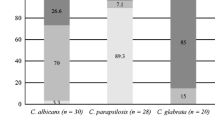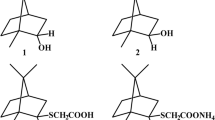Abstract
The influence of commonly used in clinical practice, antifungals (fluconazole, voriconazole, nystatin, terbinafine), on Candida albicans cell cultures was investigated. Clinical strains isolated from patients with clinical signs of superficial candidal infections of various localizations were tested. Sensitivity of strains to drugs on planktonic cells and in the biofilms was determined. Strains with various levels of sensitivity and resistant to antimycotics were identified. It was established that MICs of the antifungal drugs which inhibit the growth of the biofilms were up to 1000 times higher than MICs, inhibiting growth of planktonic cells.
Similar content being viewed by others
1 Introduction
The infections caused by Candida fungi became a vital issue in recent years. At the same time, a specific place is held by Candida albicans causing deep and superficial chronic forms of diseases. About 37 % of all infectious diseases and up to 86 % of all human fungal diseases are caused by candidiases [1, 2]. The analysis of the microbiological cultures allocated from the patients observed at the laboratory of mycology at the Kazan Scientific Research Institute of Epidemiology and Microbiology during the period 2010–2015 revealed that C. albicans are the second in allocation frequency among pathogens, obtained from various anatomic loci.
Wide distribution of candidiasis, persistent chronic diseases caused by this fungus, a variety of clinical manifestations involved in pathological process of internal organs, and requirement of long-term treatment cause a special interest as to the questions of the choice of medicines and methods of treatment and to the knowledge of mechanisms of aggression and pathogenicity of fungi, for prevention of chronic infections.
The ability of C. albicans to form biofilms has important clinical value because more than 65 % of all infectious diseases are associated with the microorganisms existing in the form of biofilms.
Biofilms composed of the living cells as microcolonies surrounded by a polysaccharide matrix. Inside the biofilm, C. albicans cells can gain some new properties and increase resistance to the immune system and antifungal medications in comparison with planktonic forms [3, 4]. At the same time, subpopulations of microorganisms with the most resistant phenotype which is formed as a result of long influence of the damaging factors can survive. The ability to form biofilms explains high viability rate of yeasts, and to re-emerge a chronic infectious process. Biofilms reduce efficiency of candidiasis treatment by 100–1000 times depending on degree of their maturity. The infections associated with biofilms usually sustain antimicrobic therapy [5].
The objective of the current study was the investigation of sensitivity to antifungal drugs of various clinical strains C. albicans as planktonic cells and biofilms in vitro.
2 Materials and Methods
Sixteen strains of C. albicans allocated from the patients with clinical symptoms of a superficial candidiasis infection of various localization (mucous and skin). For quality control, the strain of C. albicans no. 4 sensitive to all types of antimycotics was used (received from a collection of TsKVI, Moscow) [6].
Identification of fungi was carried out by microscopic and biochemical methods by estimation of strain’s sensitivity to fungistatics: fluconazole (Hetero Drugs Limited), voriconazole (Sigma), nystatin (Sigma), and terbinafine (Hetero Drugs Limited).
Inoculum was prepared using 2-day-old yeast cultures grown on the Saburo dense medium, suspended to 0.5 according to McFarland, and diluted to 1–5 × 103 cells/ml.
To test the sensitivity of the planktonic C. albicans strains to the antimycotics in vitro, a CLSI M27-A3 protocol was used. MIC (minimum inhibiting concentration) estimation was carried out visually. The assessment of strain sensitivity to antimycotic treatment was done using the M27-A3 S4 method.
The C. albicans biofilm sensitivity was evaluated according to Ramage et al. [7] and Chandra et al. [8]. Biofilms formed on the 96-well polystyrene plates within 2 days.
Antimycotics were added to previously washed biofilms by the method of serial cultivations in concentration 1600 to 0.17 μg/ml and incubated for 2 days.
3 Results and Discussion
We found that the museum strain was sensitive to all types of fungistatics whereas clinical strains had resistance to some of them. The minimum inhibiting concentrations (MICs) for sensitive strains were as follows: fluconazole ≤ 3.12 μg/ml, voriconazole ≤ 1.5 μg/ml, nystatin ≤ 3.12 μg/ml, and terbinafine ≤ 0.17 μg/ml. The maximum values of the antifungal drugs inhibiting the growth of strains with a strong resistance were as follows: for fluconazole ≤ 50 μg/ml, for voriconazole ≤ 50 μg/ml, for nystatin ≤ 25 μg/ml, and for terbinafine ≤ 25 μg/ml. One clinical strain isolated from the skin was found to be resistant to fluconazole. The maximum concentrations for the medications suppressing biofilm growth for some strains were fluconazole ≤ 1600 μg/ml, for nystatin ≤ 200 μg/ml, and for terbinafine ≤ 800 μg/ml, while the minimum concentrations were ≤400 μg/ml, ≤100 μg/ml, and ≤12.5 μg/ml respectively. Biofilms of all fungi strains were found resistant to voriconazole. The strain that possessed resistance to fluconazole maintained it in biofilms as well. Nystatin had higher activity to biofilms in all strains. However, we have found a number of features in the ability of clinical strains of C. albicans to proliferate biofilms under fungistatics treatment. Fluconazole stimulated a biofilm proliferation more than twofold in concentration of 50 μg/ml in the K-203 strain allocated from the skin compared to control (0.5 + 0.01 and 0.24 + 0.01 respectively) and in concentration of 200 μg/ml in strains K-230 and K-249 allocated from the mucous ((0.45 + 0.01) (0.32 + 0.02) and (0.18 + 0.01) (0.12 + 0.01) respectively). Terbinafine increased a biofilm growth at least twofold in concentration of 3.1 and 400 μg/ml only in one strain allocated from nail plates.
The study of antifungal effect on the initial process of biofilm formation by clinical strains of in vitro revealed different activity of medications depending on strain and medication. Despite the fact that all antifungal medications inhibited formation of a biofilm, we observed some stimulating effect in particular concentrations. Formation of a biofilm cell of C. albicans increased more than two times under nystatin treatment in concentration of 12.5 μg/ml (0.3 + 0.01 and 0.1 + 0.01 respectively).
The antifungal medication widely applied in clinical practice—terbinafine in concentration of 100 μg/ml stimulated process of film formation of a clinical strain of C. albicans no. L-16 allocated from a pharynx mucous. Fluconazole had the oppressing effect on a biofilm formation in both low and high concentrations.
4 Conclusion
The obtained results testify to ambiguous nature of antifungal medications effect on clinical strains of C. albicans as a biofilm form. Fungi in biofilms demonstrated resistance to all types of preparations (MIC suppressed biofilm growth sometimes 1000-fold exceeded MIC that suppressed growth of planktonic cells). It is required to account a possibility of biofilm formation in C. albicans during antifungal therapy, antimycotics selection, and its dosage.
References
Achkar, J. M., & Fries, B. C. (2010). Candida infections of the genitourinary tract. Clinical Microbiology Reviews, 23, 253–273.
Kumari, V., Banerjee, T., Kumar, P., Pandey, S., Tilak, R. (2013). Emergence of nonalbicans Candida among candidal vulvovaginitis cases and study of their potential virulence factors, from a tertiary care center, North India. Indian Journal of Pathology and Microbiology, 56, 144–147.
Tobudic, S., Kratzer, C., Lassnigg, A., Prestrel, E. (2011). Antifungal susceptibility of Candida albicans in biofilms. Mycoses, 55, 199–204.
Pierce, C. G., Uppuluri, P., Tristan, A. R., Wormley, F. L., Jr., Mowat, E., Ramage, G., et al. (2008). A simple and reproducible 96 well plate-based method for the formation of fungal biofilms and its application to antifungal susceptibility testing. Nature Protocols, 3, 1494–1500.
Pinegina, O. N., Raush, E. R., Vasilyeva, N. V. (2014). Testing of antifungal susceptibility of Candida in biofilms. Problems in Medical Mycology, 16, 46–48.
Kulikov, S. N., Lisovskaya, S. A., Bezrodnykh, E. A., Zelenikhin, P. V., Shakirova, D. R., Tikhonov, V. E. (2014). Antifungal activity of oligochitosans (short chain chitosans) against some Candida species and clinical isolates of C. albicans: molecular weight–activity relationship. European Journal Medicinal Chemistry, 74, 169–178.
Ramage, G., Walle, K. V., Wickes, B. L., Lopez-Ribot, J. L. (2001). Standartized method for in vitro antifungal susceptibility testing of Candida albicans biofilms. Antimicrobial Agents and Chemotherapy, 45, 2475–2479.
Chandra, J., Kuhn, D. M., Mukherjee, P. K., Hoyer, L. L., McCormick, T., Ghannoum, M. A. (2001). Biofilm formation by the fungal pathogen Candida albicans: development, architecture, and drug resistance. Journal of Bacteriology, 183, 5385–5394.
Acknowledgments
This work was funded by the subsidy of the Russian Government to support the Program of Competitive Growth of Kazan Federal University among World’s Leading Academic Centers.
Author information
Authors and Affiliations
Corresponding author
Ethics declarations
Conflict of Interests
The authors declare that they have no conflict of interest.
Rights and permissions
About this article
Cite this article
Lisovskaya, S., Khaldeeva, E., Salmakova, A. et al. Evaluation of the Influence of Antifungal Drugs on Growth of Candida albicans in the Biofilm. BioNanoSci. 6, 588–590 (2016). https://doi.org/10.1007/s12668-016-0291-0
Published:
Issue Date:
DOI: https://doi.org/10.1007/s12668-016-0291-0




